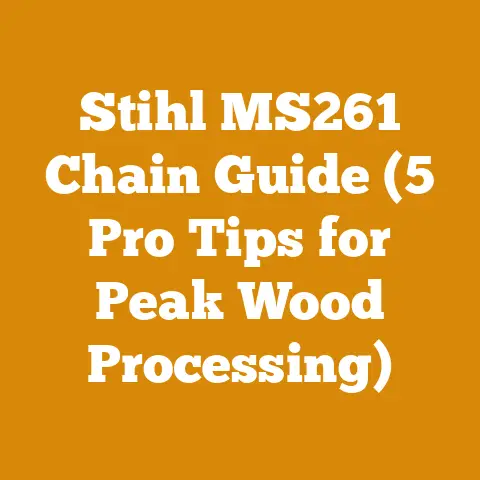Identifying Michigan Trees by Leaves (5 Expert Tips for Woodcutters)
Ever wondered how knowing your trees can save you a fortune in the woodcutting game? Let’s dive into how identifying Michigan trees by their leaves can sharpen your woodcutter’s edge, not just in terms of technique, but also in terms of cold, hard cash. I’m going to share five expert tips and break down the often-murky world of firewood preparation costs, logging tool expenses, and timber valuation, all while keeping it real with personal anecdotes and industry insights.
Identifying Michigan Trees by Leaves: 5 Expert Tips for Woodcutters & Budgeting for Wood Processing
Knowing your trees is more than just a cool party trick for a woodcutter. It’s a fundamental skill that directly impacts the bottom line. Understanding the species you’re dealing with influences everything from the value of the timber to the efficiency of your firewood processing.
1. The Leaf is Your Business Card: Visual Identification & Species Value
Forget textbooks filled with botanical jargon. Let’s talk practical identification. In Michigan, we’re blessed (and sometimes cursed) with a diverse range of hardwoods and softwoods. Being able to quickly identify them by their leaves is your first step to smart woodcutting.
- Oak (Red, White, Black): Oak leaves are easily recognizable by their lobed shapes. Red oak usually has pointed lobes, while white oak has rounded lobes. Black oak leaves are similar to red oak but often have a more bristle-tipped lobe. Oak is prized for its density and heat output, making it a top-tier firewood choice and valuable timber. As of late 2023, standing red oak timber in Michigan can fetch anywhere from $400 to $700 per thousand board feet (MBF), depending on quality and location. White oak often commands a premium.
- Maple (Sugar, Red, Silver): Maple leaves are palmate, meaning they resemble a hand with lobes radiating from a central point. Sugar maple leaves have smooth edges, while red maple leaves have serrated edges. Silver maple leaves are deeply lobed and silvery on the underside. Maple is a good firewood option, though not as dense as oak. Sugar maple, however, is highly valued for furniture making. Expect sugar maple timber prices to range from $300 to $600 per MBF.
- Ash (White, Green): Ash leaves are compound, meaning they consist of multiple leaflets. White ash leaves have 5-9 leaflets, while green ash leaves have 7-11 leaflets. Ash is a decent firewood, but it’s also susceptible to the emerald ash borer, impacting its value. Firewood prices are about $150-$300 a cord, or about $200-$450 per MBF.
- Birch (Yellow, Paper): Birch leaves are oval-shaped with serrated edges. Yellow birch has hairy twigs, while paper birch has smooth, white bark. Birch is a relatively fast-burning firewood. Timber prices are about $150-$300 a cord, or about $200-$450 per MBF.
- Poplar (Quaking Aspen): Aspen leaves are almost perfectly round with a flattened stem, causing them to tremble in the slightest breeze. Aspen is a low-density softwood, not ideal for firewood but useful for pulpwood. Pulpwood prices are about $50 – $100 a cord.
The Cost Connection: Misidentifying a valuable oak as a lower-grade poplar could mean leaving money on the forest floor. Let’s say you’re harvesting a stand of mixed timber. If you mistakenly price red oak at the same rate as aspen ($100/MBF instead of $500/MBF), you’re potentially losing $400 per thousand board feet! On a decent-sized harvest, this misidentification could easily cost you thousands.
2. Beyond the Basics: Leaf Characteristics & Timber Grading
It’s not just about recognizing the species. Understanding the quality of the tree is crucial for accurate valuation. Leaf characteristics can provide clues.
- Leaf Size & Health: A tree with consistently large, healthy leaves is generally a sign of a healthy, vigorous tree. This often translates to better timber quality. Small, discolored, or damaged leaves can indicate disease or stress, which may affect the wood.
- Leaf Density: A dense canopy of leaves suggests a well-nourished tree capable of producing high-quality wood. A sparse canopy might indicate nutrient deficiencies or competition from other trees.
- Branching Patterns: Observing the overall branching pattern in conjunction with the leaves can help assess the tree’s form. Straight, clear trunks with minimal branching below a certain height are highly desirable for timber.
The Cost Connection: Knowing how to grade timber based on external indicators (like leaf characteristics) allows you to negotiate better prices with buyers. Timber grading is a complex process, but a basic understanding will give you a leg up. For example, a perfectly straight oak log with minimal knots can be sold as veneer grade, fetching significantly higher prices than a sawlog. Veneer-grade oak can command prices of $1000+ per MBF, compared to $400-$700 for sawlogs.
3. Leaf Litter Clues: Soil Conditions & Wood Properties
The type of leaves on the forest floor can tell you a lot about the soil conditions, which, in turn, influence the properties of the wood.
- Oak Leaves: A thick layer of oak leaves indicates acidic soil. Oak thrives in these conditions, producing dense, durable wood.
- Maple Leaves: Maple leaves decompose relatively quickly, contributing to a more neutral soil pH. Maple wood is generally softer than oak but still has good workability.
- Pine Needles: Pine needles acidify the soil. Pine wood is softwood, typically used for construction and pulpwood.
The Cost Connection: Understanding the relationship between soil conditions and wood properties helps you predict the quality and characteristics of the timber you’re harvesting. Knowing, for example, that oak growing in acidic soil will likely be denser and more durable allows you to adjust your pricing accordingly. It also helps you make informed decisions about which trees to harvest. You can sell the oak for firewood or timber, and the pine for pulp.
4. Seasonal Leaf Changes: Timing Your Harvest for Optimal Results
The timing of your harvest can significantly impact the quality of the wood and, consequently, its value. Observing seasonal leaf changes is key.
- Fall Foliage: As leaves change color in the fall, trees begin to shut down their growth processes. Harvesting during the dormant season (late fall to early spring) minimizes sap content, reducing the risk of fungal staining and insect infestation. This is particularly important for hardwoods like maple and oak.
- Spring Bud Break: Avoid harvesting during the spring bud break. The sap is flowing heavily during this time, making the wood more susceptible to staining and decay.
- Leaf Drop: Once the leaves have completely fallen, the tree is fully dormant, making it an ideal time for harvesting.
The Cost Connection: Harvesting at the right time can save you money on drying and processing. Wood harvested during the dormant season dries faster and is less prone to warping and cracking. This reduces the amount of time and energy you need to invest in drying, ultimately lowering your costs. Proper timing reduces losses from wood degradation, which can easily devalue a load of timber by 20-30%.
5. Leveraging Technology: Leaf Identification Apps & Online Resources
In the digital age, there’s no excuse for not being able to identify trees. Numerous leaf identification apps and online resources can help you quickly and accurately identify species.
- PictureThis: Take a photo of a leaf, and the app will identify the species.
- LeafSnap: Developed by Columbia University, the University of Maryland, and the Smithsonian Institution, LeafSnap uses visual recognition software to identify trees based on their leaves.
- Arbor Day Foundation Tree Identification Field Guide: This online resource provides detailed information about tree identification, including leaf characteristics.
The Cost Connection: Using technology to accurately identify trees reduces the risk of misidentification, ensuring you’re pricing your timber correctly. These apps can also help you identify potential problems, such as disease or insect infestation, allowing you to take preventative measures and minimize losses. The cost of a subscription to a premium app (typically around $30-$50 per year) is easily offset by the potential savings from accurate identification.
Budgeting for Wood Processing and Firewood Preparation: A Deep Dive
Now that we’ve covered tree identification, let’s move on to the nitty-gritty of budgeting for wood processing and firewood preparation. This is where things can get tricky, but with a systematic approach, you can keep your costs under control and maximize your profits.
1. Understanding the Variable Factors: Setting Realistic Expectations
Before you even think about cutting a single tree, it’s crucial to acknowledge the variable factors that will impact your costs. These include:
- Wood Species: As we discussed earlier, different species have different values. Oak and maple command higher prices than aspen and birch.
- Wood Quality: The quality of the wood (straightness, knot density, presence of defects) will affect its grade and value.
- Location Accessibility: If the timber is located in a remote or difficult-to-access area, your harvesting and transportation costs will be higher.
- Seasonality: The time of year will affect drying times and the risk of wood degradation.
- Equipment: The type and condition of your equipment will impact your efficiency and maintenance costs.
- Labor: Whether you’re doing the work yourself or hiring a crew, labor costs are a significant factor.
- Permits & Regulations: Depending on your location, you may need permits to harvest timber or sell firewood.
- Market Demand: The demand for firewood and timber will fluctuate depending on the season and economic conditions.
My Experience: I once underestimated the impact of location accessibility on a timber harvest. The stand of oak was located on a steep hillside with limited road access. I had to rent specialized equipment to get the logs out, which significantly increased my costs. I ended up making far less profit than I had anticipated.
2. Breaking Down the Cost Components: A Systematic Approach
To create an accurate budget, you need to break down all the cost components involved in wood processing and firewood preparation. These typically include:
- Timber Purchase or Harvesting Costs: This is the cost of acquiring the raw material. If you’re buying timber, this is the price you pay per MBF or cord. If you’re harvesting your own timber, this includes the cost of permits, stumpage fees (if applicable), and any other associated expenses.
- Tool Costs: Chainsaws, axes, wedges, splitting mauls, log splitters – these are essential tools for wood processing and firewood preparation. Include the purchase price, maintenance costs (oil, chains, spark plugs), and replacement costs in your budget.
- Fuel & Lubrication: Chainsaws, log splitters, and other equipment require fuel and lubrication. Estimate your fuel consumption based on your equipment and the volume of wood you’re processing.
- Labor Wages: If you’re hiring a crew, you need to factor in labor wages, including hourly rates, payroll taxes, and worker’s compensation insurance.
- Transportation Costs: This includes the cost of transporting timber from the forest to your processing site, as well as the cost of delivering firewood to customers.
- Drying Costs: If you’re selling firewood, you need to factor in the cost of drying the wood. This may include the cost of a wood kiln or the cost of storing the wood in a covered area.
- Marketing & Sales: If you’re selling firewood or timber, you need to factor in the cost of marketing and sales, including advertising, website development, and customer service.
- Permits & Licenses: Depending on your location, you may need permits to harvest timber or sell firewood.
- Insurance: Liability insurance is essential to protect yourself from accidents and injuries.
- Depreciation: Account for the depreciation of your equipment over time.
- Contingency Fund: Always set aside a contingency fund to cover unexpected expenses. A good rule of thumb is to allocate 10-15% of your total budget to this fund.
Example Budget: Let’s say you’re planning to harvest and process 10 cords of firewood. Here’s a sample budget:
| Cost Component | Estimated Cost | Notes |
|---|---|---|
| Timber Purchase | $500 | Assuming you’re buying standing timber at $50 per cord. |
| Chainsaw Maintenance | $50 | Includes oil, chains, spark plugs, and other routine maintenance. |
| Fuel & Lubrication | $100 | Estimate fuel consumption based on chainsaw and log splitter usage. |
| Labor (Self) | $0 | If you’re doing the work yourself, you may not include a direct labor cost, but consider the opportunity cost of your time. |
| Log Splitter Rental | $200 | Assuming you’re renting a log splitter for a few days. |
| Transportation | $100 | Cost of hauling timber and delivering firewood. |
| Drying Costs | $50 | Cost of storing firewood in a covered area. |
| Marketing & Sales | $50 | Cost of advertising and customer service. |
| Permits & Licenses | $0 | Assuming no permits are required. |
| Insurance | $25 | Pro-rated cost of liability insurance. |
| Contingency Fund (10%) | $127.50 | 10% of total estimated costs. |
| Total Estimated Cost | $1277.50 |
Based on this budget, your cost per cord of firewood is approximately $127.75. To make a profit, you need to sell the firewood for more than this amount.
3. Industry Benchmarks and Statistical Data: Keeping it Real
To ensure your budget is realistic, it’s essential to compare your estimated costs to industry benchmarks and statistical data. Here are some key data points to consider:
- Average Price per Cord of Firewood: According to the U.S. Energy Information Administration (EIA), the average price of firewood in the United States in 2023 ranged from $200 to $400 per cord, depending on the region and species. In Michigan, expect to pay around $250-$350 per cord for seasoned hardwood.
- Timber Prices: Timber prices fluctuate depending on species, quality, and market demand. The Timber Mart-South publishes regular reports on timber prices in the Southern United States. The Michigan Department of Natural Resources (DNR) also provides information on timber sales and stumpage rates.
- Equipment Rental Fees: Rental fees for log splitters and other equipment vary depending on the location and the type of equipment. Expect to pay around $50-$100 per day for a standard log splitter.
- Labor Wages: According to the Bureau of Labor Statistics (BLS), the median hourly wage for logging workers in the United States in May 2022 was $20.85. In Michigan, wages may be slightly lower.
- Fuel Prices: Fuel prices fluctuate depending on global market conditions. Keep an eye on fuel prices when budgeting for wood processing and firewood preparation.
My Insight: I always track my fuel consumption and maintenance costs for each piece of equipment. This allows me to accurately estimate these costs for future projects and identify areas where I can improve efficiency. I use a simple spreadsheet to track this data.
4. Practical Tips for Cost Optimization: Squeezing Every Penny
Now that you have a good understanding of the cost components involved in wood processing and firewood preparation, let’s look at some practical tips for cost optimization:
- Negotiate Timber Prices: Don’t be afraid to negotiate with landowners or timber buyers. Shop around and get multiple quotes before making a decision.
- Buy Used Equipment: Buying used equipment can save you a significant amount of money. Just be sure to inspect the equipment thoroughly before you buy it.
- Maintain Your Equipment: Regular maintenance will extend the life of your equipment and prevent costly repairs.
- Improve Your Efficiency: Look for ways to improve your efficiency in all aspects of wood processing and firewood preparation. This could include optimizing your cutting techniques, improving your workflow, or investing in more efficient equipment.
- Dry Your Firewood Properly: Properly dried firewood burns more efficiently and is less likely to cause problems in wood stoves and fireplaces. This can save your customers money on heating costs, making your firewood more valuable.
- Market Your Firewood Effectively: Effective marketing can help you attract more customers and sell your firewood at a higher price. Consider advertising in local newspapers, online marketplaces, and social media.
- Bundle Your Services: Consider offering additional services, such as firewood delivery and stacking, to increase your revenue.
- Sell Your Byproducts: Don’t throw away your byproducts, such as wood chips and sawdust. These can be sold as mulch or used for other purposes.
- Take Advantage of Tax Deductions: Be sure to take advantage of all applicable tax deductions for your wood processing and firewood preparation business. Consult with a tax professional to ensure you’re maximizing your deductions.
My Strategy: I’ve found that investing in a high-quality wood moisture meter is well worth the cost. By ensuring that my firewood is properly dried, I can command a premium price and reduce customer complaints. I aim for a moisture content of 20% or less.
5. Calculations and Formulas: The Math Behind the Wood
Understanding the math behind wood processing and firewood preparation is essential for accurate budgeting and cost management. Here are some relevant calculations and formulas:
- Calculating Volume of Logs in Board Feet: The Doyle Log Scale is a common method for estimating the board foot volume of logs. The formula is: Board Feet = (Diameter – 4)² x Length / 16. Diameter is measured in inches, and Length is measured in feet.
- Calculating Volume of Logs in Cords: A cord is a unit of volume equal to 128 cubic feet. To estimate the number of cords in a pile of logs, multiply the length, width, and height of the pile in feet, and then divide by 128.
- Estimating Drying Time: The drying time for firewood depends on several factors, including the species of wood, the moisture content, the climate, and the storage conditions. As a general rule, hardwoods like oak and maple take at least 6-12 months to dry properly. Softwoods like pine and aspen dry faster, typically in 3-6 months.
- Calculating BTU Content: The BTU (British Thermal Unit) content of firewood varies depending on the species and moisture content. Oak has a higher BTU content than aspen. Dry firewood has a higher BTU content than wet firewood.
- Calculating Profit Margin: Profit Margin = (Revenue – Cost) / Revenue. This formula tells you what percentage of your revenue is profit.
My Tip: I use a spreadsheet to track all my calculations and formulas. This helps me stay organized and avoid errors. There are also specialized software programs available for timber cruising and wood processing that can automate many of these calculations.
Conclusion: Actionable Takeaways for Woodcutters and Budget Planners
Identifying Michigan trees by their leaves is more than just a fun fact; it’s a crucial skill for successful woodcutters. It allows you to accurately assess the value of timber, make informed harvesting decisions, and optimize your wood processing operations. Combined with a solid understanding of budgeting and cost management, this knowledge will empower you to thrive in the wood processing and firewood preparation industry.
Here are some actionable takeaways for woodcutters and budget planners:
- Invest in Tree Identification Skills: Learn to identify Michigan trees by their leaves and other characteristics.
- Develop a Detailed Budget: Break down all the cost components involved in wood processing and firewood preparation.
- Track Your Expenses: Monitor your expenses closely and compare them to your budget.
- Optimize Your Costs: Look for ways to reduce your costs and improve your efficiency.
- Stay Informed: Keep up-to-date on industry trends, timber prices, and equipment advancements.
- Seek Expert Advice: Don’t be afraid to seek advice from experienced woodcutters, foresters, and business professionals.
By following these tips, you can sharpen your woodcutter’s edge, optimize your budget, and achieve your goals in the wood processing and firewood preparation industry. Now, go forth and conquer the forest!






